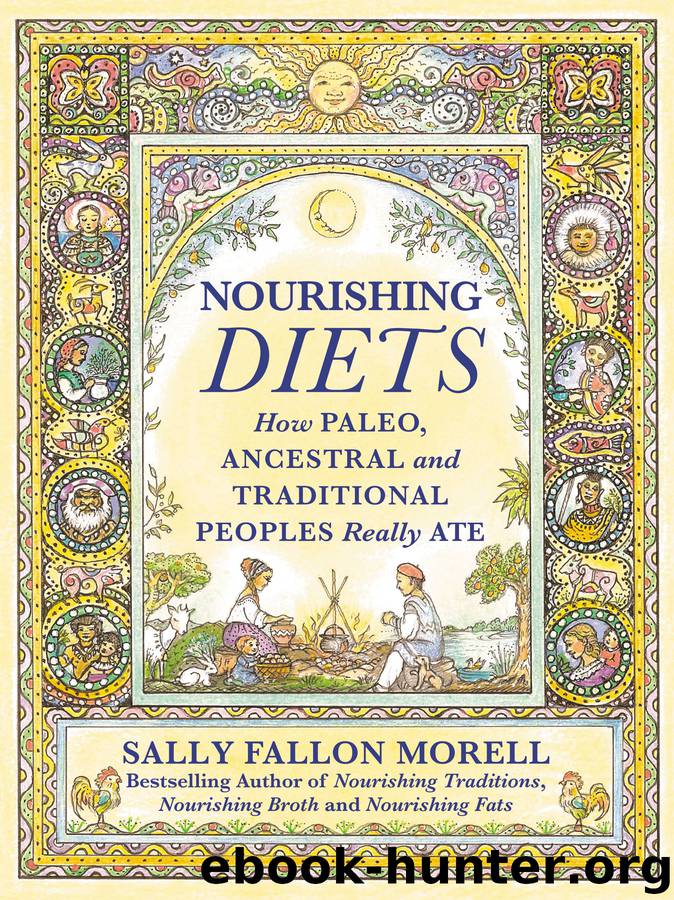Nourishing Diets by Sally Fallon Morell

Author:Sally Fallon Morell
Language: eng
Format: epub
Tags: Cooking / Health & Healing / General, Cooking / History, Health & Fitness / Diet & Nutrition / Diets, Health & Fitness / Diet & Nutrition / Nutrition
Publisher: Grand Central Publishing
Published: 2018-05-22T04:00:00+00:00
THE FOODS OF THAILAND do not fit the low-fat, high-fiber, largely vegetarian paradigm said to protect us against disease. There’s no denying that the delicious, spicy cuisine of Thailand is rich in saturated fat from coconut oil and lard, relatively low in fiber, and features many and varied animal foods. Yet a 1962 comparison of autopsy reports on a group from Bangkok with a group from the United States found that coronary occlusion or myocardial infarction was eight times more frequent in the United States, diabetes was ten times more frequent, and high blood pressure about four times more frequent.53 Even more intriguing is the fact that Thailand has a very low rate of cancer compared to other countries around the world; in 1996, Thailand rated fiftieth in frequency of cancer compared to other nations.54 Today, Thailand is not even listed among the fifty nations where cancer rates are the highest.55 Here is yet another paradox—like the French paradox or the Japanese paradox—that the “experts” would rather ignore than explain.
“Thai cooking is an art form,” writes Pinyo Srisawat in The Elegant Taste of Thailand,56 and as anyone who has frequented a Thai restaurant knows, a particularly delicious art form. Mouth-watering curries and soups made from chicken or fish broth, creamy with whole coconut milk, offer the palate a variety of delicious spices and flavors, including coriander, anise, cumin, nutmeg, lemongrass, chile, ginger, turmeric, basil, mint, garlic and lime. Seafood is plentiful in the Thai diet, including fresh saltwater and freshwater fish, mackerel, shrimp, crab and eels, along with salted fish and dried fish. Fermented fish sauce and shrimp paste are popular seasonings. Pork and beef are consumed by those who can afford them, often raw or pickled. Other animal foods less likely to feature on restaurant menus, but consumed in the villages, include duck and chicken and their eggs, water buffalo, and more unusual items like snails, caterpillars, lizards, frogs, rats, snakes, squirrels and other small animals.
Plant foods include eggplant, onions, cabbage, baby corn, mushrooms, kale, mustard greens, radish, celery, cucumber, lettuce, several varieties of vegetable gourd, water chestnuts and swamp cabbage, which grows in ditches and rice paddies. Fruits include plums, tamarinds and bananas. Two plant foods are particularly associated with Thai cuisine. One is the kaffir lime (Citrus hystrix), with a distinctive wrinkled skin. The rind and leaves give a wonderful flavor to soups and curries. The other is bitter melon (Momordica charantia), of which there are several varieties. Bitter melon looks like a lime-green elongated cucumber with a furrowed, convoluted rind. The pulp is very bitter—an acquired taste for Americans—but the Thais are fond of it and believe it has potent healing qualities.*
Soy foods play a minor role in Thai cooking. Bean curd is a common ingredient in soups, while fermented soybeans, soybean paste and soy sauces serve as flavorings. The Thai consume other legumes in larger quantities, such as black beans and mung beans, either sprouted or as an ingredient in sweets. Yard-long beans and winged beans serve as vegetables.
Download
This site does not store any files on its server. We only index and link to content provided by other sites. Please contact the content providers to delete copyright contents if any and email us, we'll remove relevant links or contents immediately.
The Bone Broth Miracle: How an Ancient Remedy Can Improve Health, Fight Aging, and Boost Beauty by Ariane Resnick(16505)
How to Be a Bawse: A Guide to Conquering Life by Lilly Singh(7346)
The Fat Loss Plan by Joe Wicks(4758)
The Ultimate Bodybuilding Cookbook by Kendall Lou Schmidt(3856)
The French Women Don't Get Fat Cookbook by Mireille Guiliano(3544)
A Jewish Baker's Pastry Secrets: Recipes from a New York Baking Legend for Strudel, Stollen, Danishes, Puff Pastry, and More by George Greenstein(3503)
Better Homes and Gardens New Cookbook by Better Homes & Gardens(3490)
Super Food Family Classics by Jamie Oliver(3338)
Bread Revolution by Peter Reinhart(3052)
Dinner in an Instant by Melissa Clark(3051)
Tom Kerridge's Dopamine Diet: My low-carb, stay-happy way to lose weight by Kerridge Tom(3042)
Body Love by Kelly LeVeque(2987)
Ottolenghi - The Cookbook by Yotam Ottolenghi(2805)
Flavor Flours by Alice Medrich(2732)
Tone Your Tummy Type by Denise Austin(2729)
The Fat Chance Cookbook by Robert H. Lustig(2727)
Oh She Glows Every Day by Angela Liddon(2680)
LL Cool J's Platinum 360 Diet and Lifestyle by LL Cool J(2663)
The Kitchen Counter Cooking School by Kathleen Flinn(2456)
